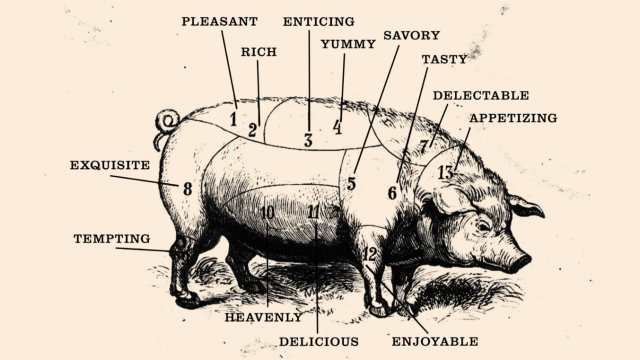About three years ago, I removed a pig’s face from its skull, packed it with herbs, zest, and spices, and sous-vided it for many hours to make a porchetta di testa. This process was recorded and made into a video (my first for Lifehacker), and it made a lot of people very angry.
I got some threats, one of which was levelled at my spaniel, who briefly appears in the video, but most of the reactions were ones of shock, disgust, and horror. (The video was even blurred out on Facebook for “offensive content” for a spell.) Other people were just “weirded out,” which is the most boring thing you can be.
I was not surprised by the backlash from vegetarians and vegans. If you have decided that meat is not for you, then a video featuring animal butchery and cookery is probably not the content you crave, and I understand the thought process behind your displeasure. What I find incredibly absurd, however, is the number of meat-eaters who expressed horror and disgust when confronted with the head of a dead animal. If you do not like that your food had a face at one point, you probably should not eat things with faces.
There’s far more cruelty (and negative environmental impact) involved in the making of a neat little chicken nugget than there was in the making of that particular porchetta di testa. (I guess it is possible that a more humane chicken nugget exists, but the vast majority are mass-produced and factory-farmed.) The head I used in the video had been purchased from a local farmer a few miles away from where I lived, and belonged to a pig that was raised far more humanely than most meat you can buy in the grocery store. This disconnect from meat is a problem in the United States, particularly with white people who grew up seeing their future dinners packaged in tidy Styrofoam packages.
Any time I write about a meat that falls slightly outside the white American diet, a bit of this backlash pops up. (Not so much in the comments, as Lifehacker commenters are pretty good most of the time, but it happens without fail on Twitter.) Offal of any kind, anything with a lot of bone and connective tissue (such as chicken feet), and anything that’s not chicken, beef, pork, or lamb elicits a wide range of displeasure, from puke face emojis to blatant racism and classism.
The racism and classism are not accidental. According to Scientific America, this division between muscle meat and offal goes back to the days of slavery:
Another dimension in the USA is historical – for a very long time, whenever an animal at a farm was slaughtered, the owners got the steaks, and the slaves got the offal…I have noticed especially here down South, that the country-club-whites especially look down their noses with disdain at offal dishes and their almost visceral disgust with them has more than a little of a classist and racist tinge to it.
This continues to permeate attitudes about meat today. Though liver, chitlins, and tripe are somewhat normalised in the American south, you won’t find them on the supper table of middle-class white homes. I grew up visiting my father and grandparents every summer in Mississippi, and though they would talk about members of our family eating organ meat, it was never served to me. I was never outright told that such meat was “for poor people,” but I knew the family members my grandmother was referring to were poor, and my young mind made the connection on its own.
Somewhat predictably, offal has become quite popular with the upperclass foodie set over the last decade, as upperclass foodies are always trying to distinguish themselves as not only appreciators of the “authentic,” but different than and separate from the unenlightened “normie” middle class. You can find “best of offal” lists for cities like New York and Portland, and the restaurants featured usually fall into two distinct categories: eateries and food carts that feature reasonably priced food made by people of colour, and expensive, white-owned, often award-nominated restaurants that make it on to all sorts of fancy “lists.” The difference lies not in quality of preparation, but in the setting in which it is served, the plating, and (sometimes) smaller, “neater” portion sizes. (Often there is a “French,” quality to the fancy offal; Frenchifying is an easy way to make things acceptable to white people.)
It is almost impossible to be objective about food in a country that is so saturated with racism and classism. Food is one of the first ways we learn to “other” as children. Even as kindergarteners, American children “know” that PB&J is more “normal” than liverwurst, and children of immigrants and people of colour have to listen to white people commenting on their lunchboxes starting at a very young age. This kind of racism is annoying at the very best, but it can be devastating for a child.
Dismantling systems of oppression takes more than broadening your palate, but you can certainly start by removing the words “weird” and “gross” from your vocabulary when talking about offal and other unusual-to-you meats. Beyond the racism and classism, it just doesn’t make any sense. If you are a meat eater, seeing someone use every part of the animal — even the part with eyeballs — should thrill you. Meat is not a neat little product that comes in tidy styrofoam trays wrapped in plastic wrap. It’s a fucking animal. It had bones, it had a face, it had internal organs, and it had a life. If any of that grosses you out, then maybe eating meat is not for you.

Leave a Reply
You must be logged in to post a comment.